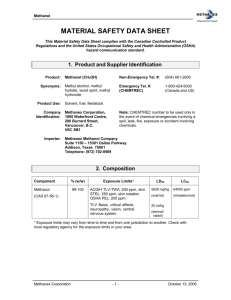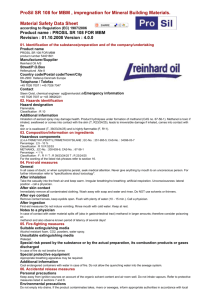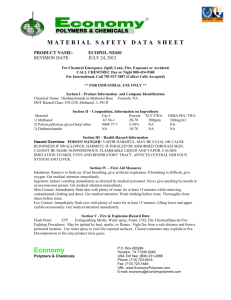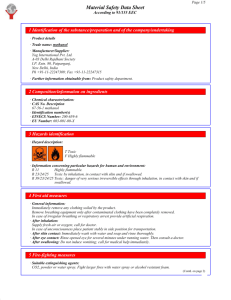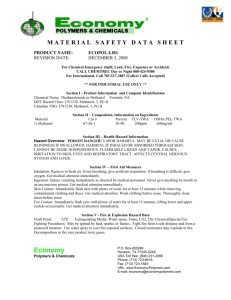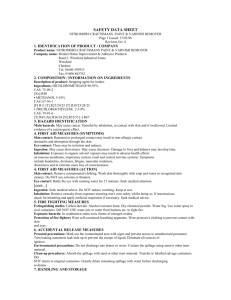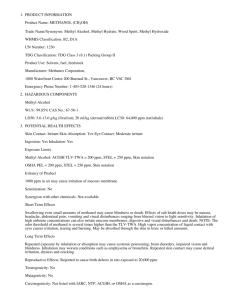CHEMFAX PRODUCTS Ltd
advertisement
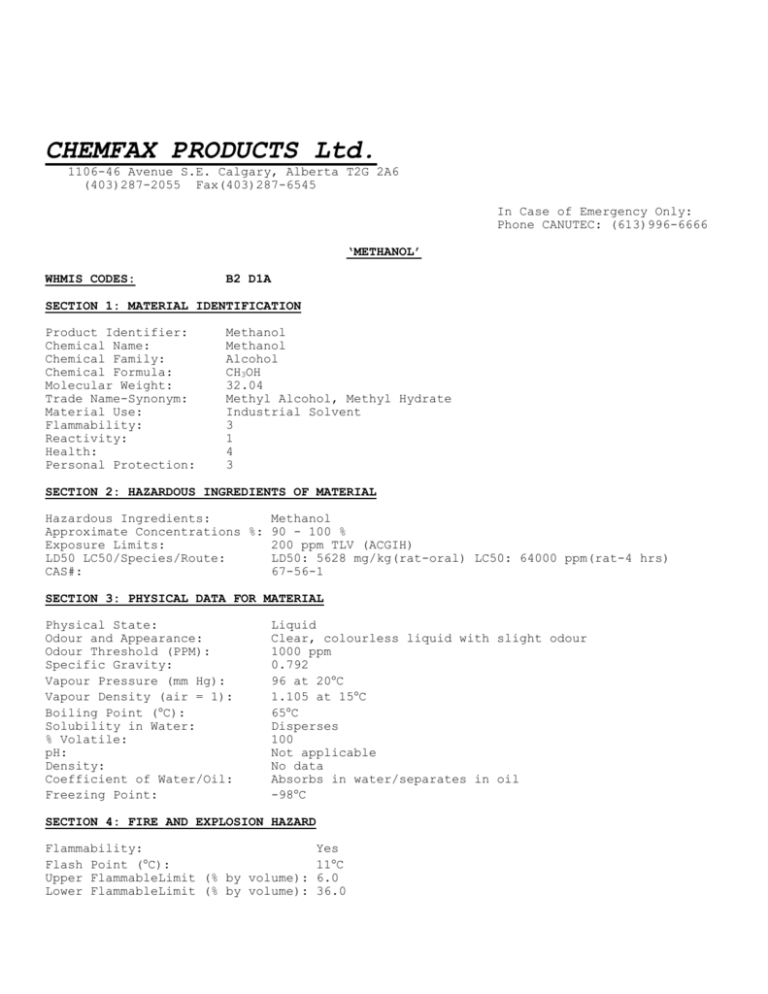
CHEMFAX PRODUCTS Ltd. 1106-46 Avenue S.E. Calgary, Alberta T2G 2A6 (403)287-2055 Fax(403)287-6545 In Case of Emergency Only: Phone CANUTEC: (613)996-6666 ‘METHANOL’ WHMIS CODES: B2 D1A SECTION 1: MATERIAL IDENTIFICATION Product Identifier: Chemical Name: Chemical Family: Chemical Formula: Molecular Weight: Trade Name-Synonym: Material Use: Flammability: Reactivity: Health: Personal Protection: Methanol Methanol Alcohol CH3OH 32.04 Methyl Alcohol, Methyl Hydrate Industrial Solvent 3 1 4 3 SECTION 2: HAZARDOUS INGREDIENTS OF MATERIAL Hazardous Ingredients: Methanol Approximate Concentrations %: 90 - 100 % Exposure Limits: 200 ppm TLV (ACGIH) LD50 LC50/Species/Route: LD50: 5628 mg/kg(rat-oral) LC50: 64000 ppm(rat-4 hrs) CAS#: 67-56-1 SECTION 3: PHYSICAL DATA FOR MATERIAL Physical State: Odour and Appearance: Odour Threshold (PPM): Specific Gravity: Vapour Pressure (mm Hg): Vapour Density (air = 1): Boiling Point (C): Solubility in Water: % Volatile: pH: Density: Coefficient of Water/Oil: Freezing Point: Liquid Clear, colourless liquid with slight odour 1000 ppm 0.792 96 at 20C 1.105 at 15C 65C Disperses 100 Not applicable No data Absorbs in water/separates in oil -98C SECTION 4: FIRE AND EXPLOSION HAZARD Flammability: Yes Flash Point (C): 11C Upper FlammableLimit (% by volume): 6.0 Lower FlammableLimit (% by volume): 36.0 Autoignition Temperature (C): Hazardous Combustion Products: Explosive Power: Sensitivity to Static Discharge: Means of Extinction: Special Procedures: 385C Toxic gases and vapours such as carbon monoxide Extreme hazard when exposed to heat, sparks, flames Low Water spray, CO2, dry chemical Use water spray to cool structures or containers when exposed to fire. Fire fighters must wear full protective clothing and self contained breathing apparatus. Vapours are heavier than air and may flow along surfaces to source of ignition. Methanol burns with a clear flame, being almost invisible in daylight. SECTION 5: REACTIVITY Chemical Stability: Under Fire Conditions: Incompatibility to Products: Reactivity, and under what Conditions: Hazardous Decomposition Products: Hazardous Polymerization: Conditions to Avoid: Materials to Avoid: Stable Flammable Strong oxidizers, strong acids In contact with the following violent reactions may occur:- bromine, calcium carbide, chromic anhydride, beryllium hydride, cyanuric chloride, magnesium & nickel Formaldehyde and carbon monoxide Will not occur Keep away from any source of ignition Nitrates, perchlorates, sulfuric acid and the following:- bromine, calcium carbide, chromic anhydride, beryllium hydride, cyanuric chloride, magnesium & nickel SECTION 6: TOXICOLOGICAL AND HEALTH DATA Route of Entry Skin Contact: Route of Entry Skin Absorption: Route of Entry Eye Contact: Route of Entry Inhalation Acute: Route of Entry Inhalation Chronic: Route of Entry Ingestion: Reproductive Effects: Mutagenicity: Teratogenicity: Carcinogenicity: Synergenistic Materials: Sensitization to Product: Exposure Limits: Irritancy of Product: LD50 LC50/Species/Route: Effects of Chronic Exposure: Effects of Acute Exposure: Yes Yes Yes Yes Yes Yes Yes Yes No data Not considered a human carcinogen Not available Prolonged exposure to Methanol may cause sensitisation in certain individuals 200 ppm TLV (ACGIH) May cause irritation to skin, eyes and mucous membranes LD50: 5628 mg/kg(rat-oral) LC50: 64000 ppm(rat-4 hrs) Repeated exposures by any route may cause systemic poisoning including various degrees of permanent visual damage. Methanol is slowly eliminated from the body, cumulative effects can be harmful. Ingestion: a poisonous narcotic which causes toxic effects compounded by repeated excessive exposures over several days. May be fatal in does of 100-250 ml. Causes nausea, cardiac depression, muscular inco-ordination, narcosis, headache, visual disturbances due to effects on the optic nerve ranging from double vision to blindness. Initial symptoms may reoccur with increased severity following a latent period of 6 to 30 days. In non-lethal cases of methanol poisoning, recover is slow and accompanied by symptoms of malaise and painful extremities. Partial or total blindness may persist for some time or be permanent. Inhalation: high concentrations may cause dizziness, stupor, cramps and digestive disturbance, unconscious and death. Initial symptoms may be mild increasing in severity after 12-18 hours. Lower concentrations may cause headache, nausea, vomiting and irritation of the mucous membrane. Skin contact: solvent action can dry the skin. Eye contact: vapours will irritate the eyes. Liquids and mists will irritate and may burn the eyes. SECTION 7: PREVENTATIVE MEASURES Personal Protective Equipment: Gloves (Specify): Respirator (Specify): Eyes (Specify): Footwear (Specify): Clothing (Specify): Other (Specify): Engineering Controls: Leak and Spill Procedure: Waste Disposal: Handling Procedures and Equipment: Storage Requirements: Special Shipping Information: Wear full protective equipment and self contained breathing apparatus. Rubber, neoprene If exposure limits are to be exceeded air purifying respirators should be worn. In the case of a severe spill, self contained breathing apparatus should be available. Safety glasses, face shield. Rubber boots. Wear chemical resistant rubber pants, jacket. Eye wash fountain, safety shower. Local exhaust ventilation. Wear protective clothing and air purifying or self contained breathing apparatus. Eliminate all sources of ignition. Ventilate area. Use inert material or mop up and dispose of in approved containers. Dilute with water to reduce fire hazard. Keep out of waterways, sewers and soil. Follow Government Regulations. Dispose of according to Federal, Provincial and Local Regulations. Use material with adequate ventilation. Keep container closed at all times. Do not smoke in area. Keep away from open flames, sparks and source of ignition. Ensure proper electrical grounding procedures are in place. Avoid natural rubbers - use neoprene. Keep away from heat, sparks and fire. Do not leave container open. Use plenty of ventilation. Store in totally enclosed equipment, designed to avoid human contact. Poisonous, Flammable.U.N. 1230 Class 3(6.1) Group 11. SECTION 8: FIRST AID MEASURES Skin: Eyes: Ingestion: Flush with plenty of water for 15 minutes. Remove contaminated clothing and call a physician immediately. Flush with plenty of water for 15 minutes holding eye lids open. Get medical attention at once. Drink plenty of water and do not induce vomiting. Also give 1 teaspoon of Inhalation: General Advice: baking soda in a glass of water and get medical attention immediately. Remove patient to fresh air. Giver artificial respiration if patient is not breathing, preferably mouth to mouth. If breathing is difficult, give oxygen and get medical attention at once. Keep out of reach of children. Do not drink or ingest. Maintain good housekeeping standards in areas of use. SECTION 9: PREPARATION DATE OF M.S.D.S. Prepared by: Technical Service Dept., Chemfax Products Ltd. (403)287-2055 November 19, 2002 Notice to reader To the best of our knowledge, the information contained herein is accurate. However, neither the above named supplier nor any of it’s subsidiaries assumes any liability whatsoever for the accuracy or completeness of the information contained herein. Final determination of suitability of any material is the sole responsibility of the user. All materials may present unknown hazards and should be used with caution. Although certain hazards are described herein, we cannot guarantee that these are the only hazards that exist. Chemfax Products Ltd. expressly disclaims all expressed or implied warranties of merchantability and fitness for a particular purpose with respect to the product provided.
